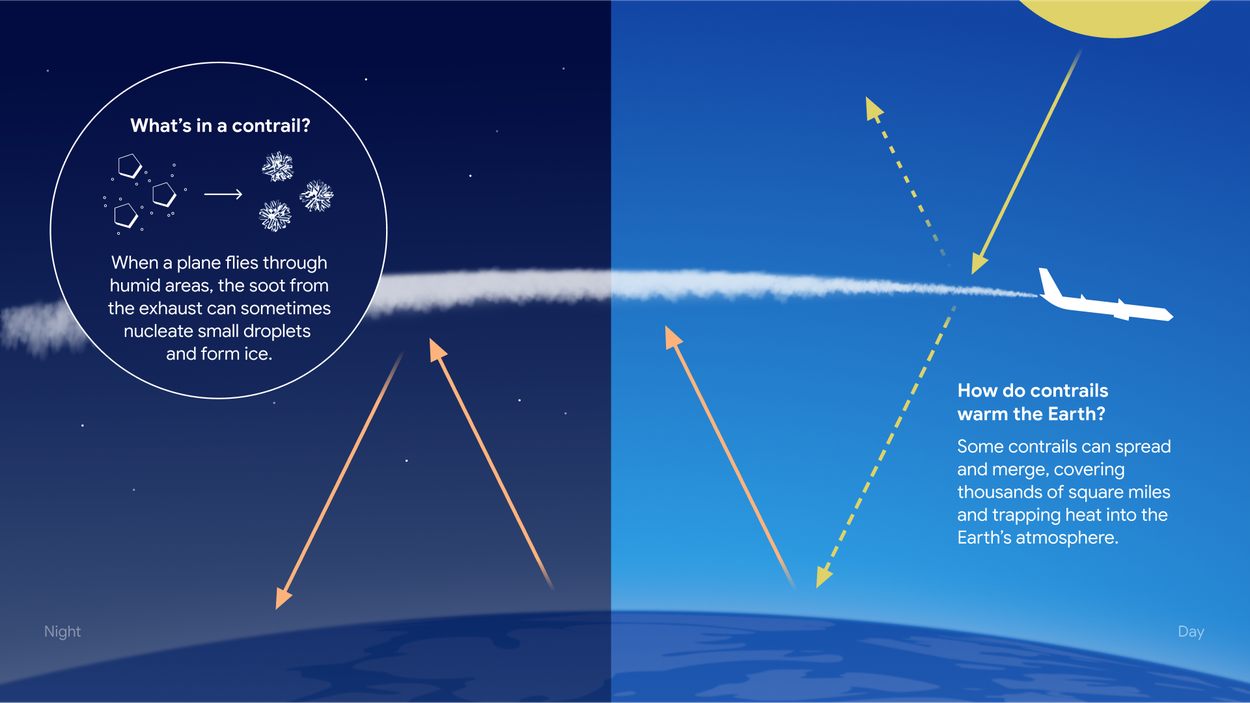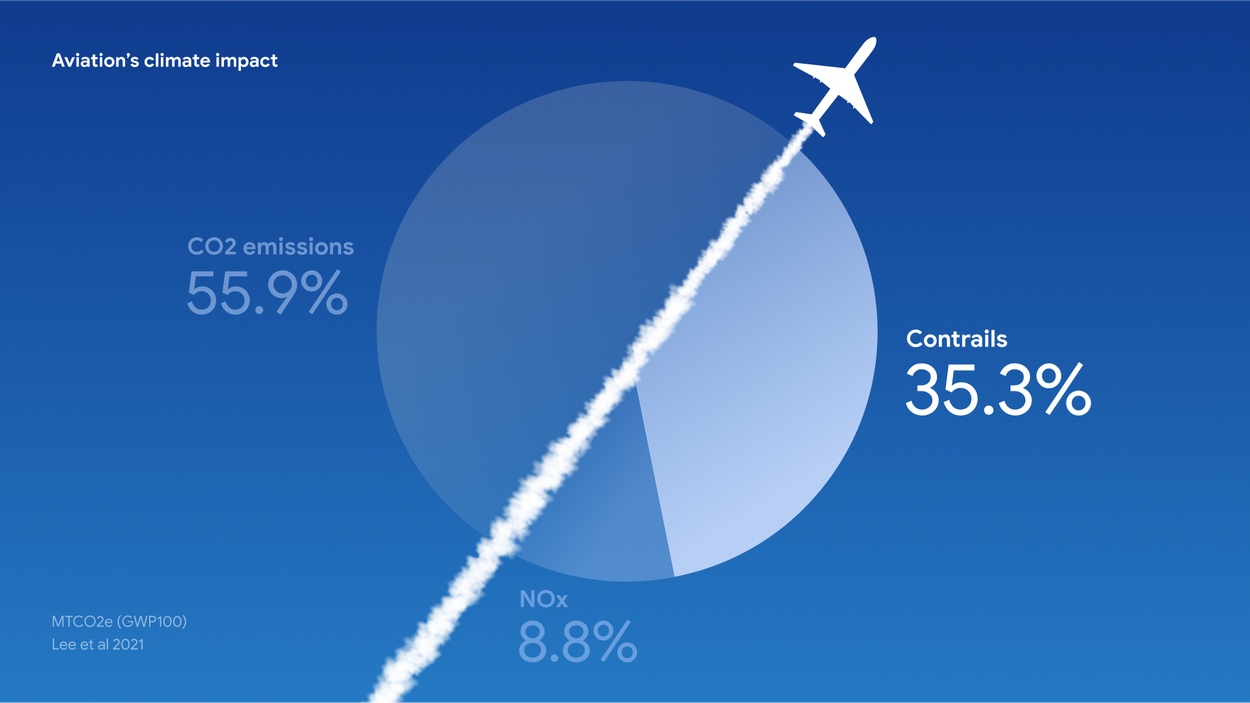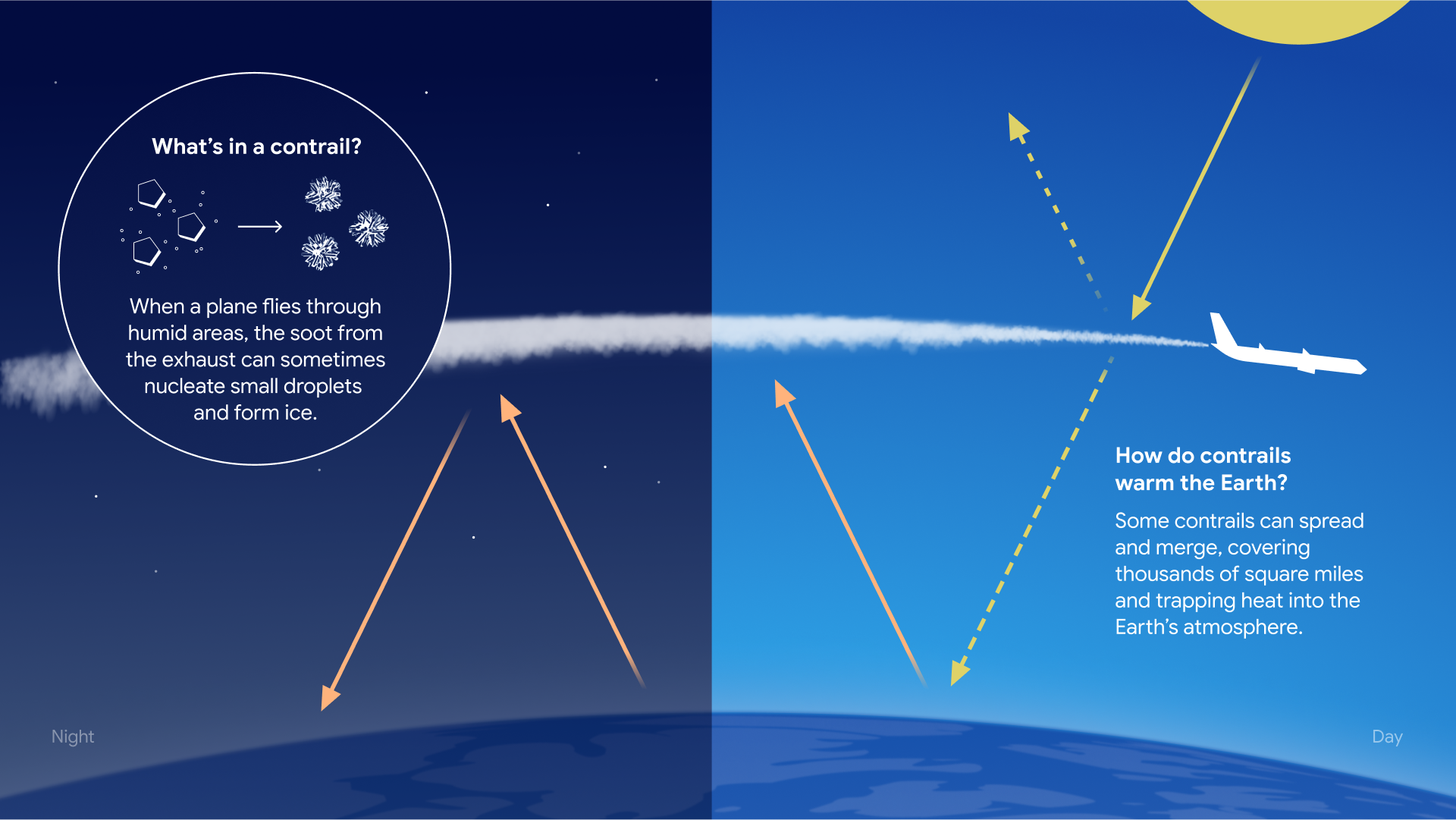Project Contrails
A cost-effective and scalable way AI is helping to mitigate aviation’s climate impact
What are contrails?
Contrails, short for condensation trails, are the line-shaped clouds that you sometimes see behind airplanes. They form when water vapor in the air condenses around tiny particles of soot and other pollutants emitted by airplane engines.

How do contrails contribute to global warming?
Contrails can persist as cirrus clouds for minutes or hours, depending on the conditions. Normally, the side of the Earth not facing the sun releases heat overnight. At night natural clouds and airline contrails trap heat. During the day, they also reflect back incoming sunlight and warmth. Nighttime contrails are more warming than daytime contrails because they do not reflect incoming sunlight and only trap heat, creating a net warming effect. A recent IPCC report noted that clouds created by contrails account for roughly 35% of aviation's global warming impact.

Only slightly over half of aviation warming comes from carbon dioxide; airlines are starting to track non-CO2 contributors.
Using Google AI to help airlines prevent contrails
Planes don’t always make contrails. Contrails only occur when planes fly through humid regions. If planes intentionally avoid flying through these regions, then they can avoid creating warming contrails, with minimal impact on fuel usage.
The challenge is knowing where these regions will occur. By combining massive quantities of weather data, satellite data, and flight data, AI can create state-of-the-art predictions of when and where contrails are likely to form. Pilots and dispatchers can then use this information to adjust the altitudes of their flights.
Our team developed an approach to leverage satellite imagery and computer vision to detect contrails and attribute them to associated flights, based on hundreds of hours of labeling tens of thousands of satellite images. The image below shows our AI detecting contrails over the United States, based on satellite imagery.
Testing with American Airlines
A group of pilots at American Airlines flew 70 test flights over six months using our AI-based predictions to avoid routes that created contrails. After these test flights, we analyzed satellite imagery and found that the predictions reduced contrails by 54% compared to when pilots didn’t use our predictions. We also saw that flights that avoided contrails burned 2% more fuel, which would translate to 0.3% more fuel when scaled across an airline’s fleet. (This is because not all flights make contrails, and with AI predictions, only a fraction of flights need to be adjusted.) Together, this suggests contrail avoidance costs could be in the range of $5-25/ton CO2e, which would make it one of the most cost-effective climate solutions.
Together with American Airlines, we achieved the industry’s first proof point that commercial airlines can verifiably avoid contrails and thereby reduce their climate impact. Read more about our work with American Airlines.
Watch the story of this research
How does it work?
- Labeled data: Our team of engineers analyzed satellite imagery and spent hundreds of hours labeling tens of thousands of contrail images collected by the geostationary satellite, GOES-16.
- Train a state-of-the-art computer vision model: We used labeled data to train a state-of-the-art computer vision model to detect contrails when they are formed. The detection model can identify contrails that are visible within GOES imagery in a matter of 30 minutes.
- Combine large datasets: We combined our computer vision model with large-scale weather data, flight data, and satellite images to develop a more accurate prediction model.
- Integrate AI insights into pilot workflow: We partnered with American Airlines to integrate contrail likely zone predictions into the tablets that their pilots used in flight, so they could make realtime adjustments in altitude, just as they do to avoid turbulence, to avoid creating contrails.
- Analyze performance results: We evaluated the prediction model's performance using satellite imagery, comparing the number of contrails produced in flights where pilots used predictions to avoid contrails to contrails created in flights where pilots didn’t use contrail predictions. For our first proof point with American Airlines, we saw a reduction of 54%.
In the future, we will extend our models to geostationary satellites over Europe, Africa, the Indian Ocean (Meteosat Third Generation), East Asia and Western Australia (Himawari).
FAQs
Google is committed to helping our users and partners take action to reduce their climate footprint, and our Google Research Climate AI teams are especially excited when we’re able to use our AI strengths to do so. This project is a powerful fusing of massive climate opportunity with a big AI challenge.
If you’re on a flight that’s avoiding contrails, you probably won’t notice anything! Pilots and dispatchers have extremely high safety standards and always put safety first. Pilots often change altitudes during a flight to avoid turbulence – changing altitudes to avoid contrails is nearly identical.
We are continuing AI research to improve our skill at predicting contrail zones, detecting contrails from satellite imagery, and understanding the climate impact of contrails. We intend to collaborate with partners to focus on nighttime flights, longer flights, and embedding our AI insights into the tools used by dispatchers so they have the most up-to-date information at their fingertips.
We’re committed to working across the aviation industry to use AI to make contrail avoidance a reality over the coming years.
The warming impact of contrails has been studied for ~30 years. In the last 2 years, there have been a number of conferences on contrail avoidance and localized trials, including a cross-sector forum spearheaded by the Rocky Mountain Institute that Google has been privileged to be a part of. The EU and UK have also recently published on the warming impact of contrails: EU Committee on Climate Change, EU Commission Study, UK Royal Aeronautical Society Report.
Recent legislation from Europe requires that airlines report their contrail climate impact in 2025.
Our teams spend a lot of time making sure we are having a net beneficial impact on the climate. When scaled up across an airline’s fleet, our results suggest that the additional fuel burn would be about 0.3%. Using numbers from the IPCC, the reduction in contrail warming is 20x greater than the additional CO2 from fuel burned.
Read more
Also check out our Kaggle competition for detecting linear contrails from satellite imagery.
Contact us
If you are a research-focused organization interested in a novel research partnership with the contrails team or interested in exploring our contrail predictions through the Trusted Tester Program, please fill out this form.

